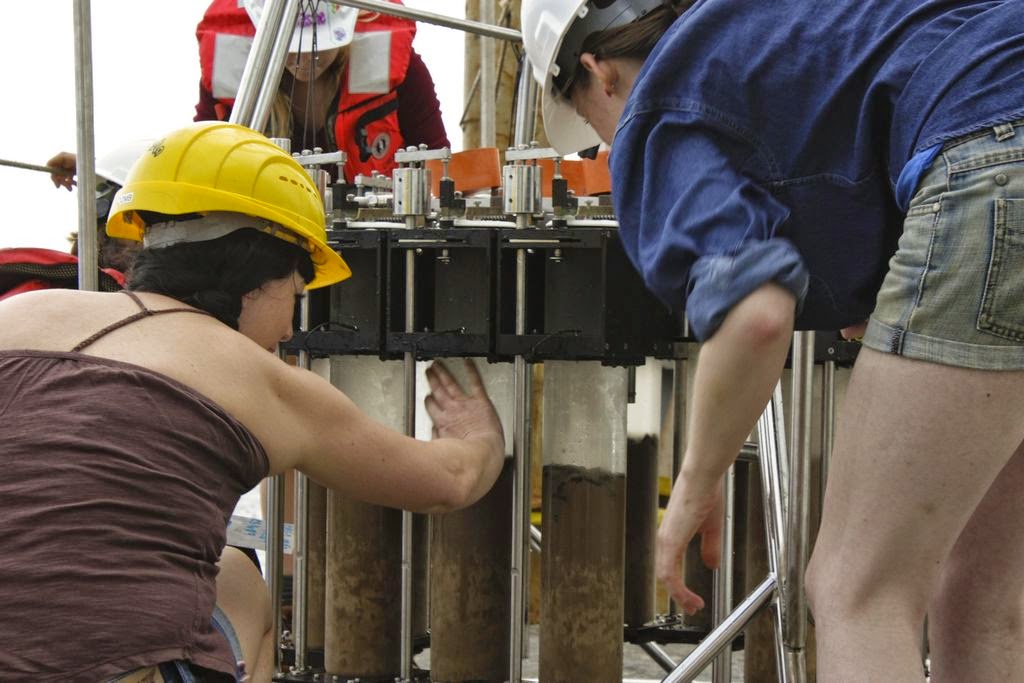Have you ever heard about benthic
foraminifera? If not, let’s introduce you to these amazing creatures.
Benthic foraminifera, affectionately known
as ‘forams’, are unicellular organisms (protozoans) living in marine sediments.
These little monsters – about 100–500 µm in size – build around their cell body
a shell also called a 'test' that can be composed of calcareous or organic material,
or agglutinated with particles found by the foram in its environment (mineral
grains, sponge spicules, radiolarians, etc...). You can find benthic forams
from salt marshes, coral reefs and other coastal environments down to abyssal and
hadal depths (including Challenger Deep, deepest site ever sampled, 10,890 m
depth), and under well-oxygenated to hypoxic (low oxygen) and even anoxic (no
oxygen) conditions. The current diversity of benthic forams has been estimated
at 3,000–5,000 living species, but at least 40,000 have existed on this earth
(who knows, they are so tough that we might find them in Martian sediments!)
since they appeared 525 million years ago (Cambrian).
So, if we had to choose one single word to
describe them, it would be ‘tough’.
Now, if you skipped the previous paragraph
because you are a geologist, and so the words ‘benthic forams’ sound familiar
to you, sorry, but forget everything you know about them. Well, no, not
everything. In the abyssal Clarion–Clipperton Fracture Zone, about 4100 m water
depth, benthic forams are still very tough guys. But they definitely do not
look like the common, classical, 'normal' forms that we can find in the fossil
record and shallower environments. We still get few ‘traditional’ species – hormosiniids,
miliolids, rotaliids, textulariids, trochamminiids – but these are a minority.
Actually, in our study area, some of the most abundant forms belong to Komokiacea,
a superfamily that typically dominates benthic foraminiferal faunas in the abyssal
deep sea. However, most of the species we find in our samples are uncommon, mainly
agglutinated or organic-walled morphotypes, often tubular in shape, and mostly
(~80%) totally new to science.
Some specimens of foraminiferans sorted on
board from ABYSSLINE 02 samples (scale bar: 500 µm).
Aurélie Goineau ‘fighting’ with Inga
Mohrbeck to get the best sediment cores from a megacorer after its recovery
from ~4100 m water depth.
Aurélie and Bin Qi Gan processing the cores
recovered from the megacorer in a cold van (2°C) in order to preserve
foraminiferal DNA for on-board live sorting. Over the past 4 weeks, we have
sorted almost 900 specimens that will be analyzed for genetic sequencing at the
University of Geneva (Switzerland).
Aurélie and Bin Qi starting to process another core from the megacorer. The core is sliced until 5 cm depth and fixed
with formaldehyde for post-cruise analysis of foraminiferal faunal density,
diversity, and taxonomical composition in our lab based in Southampton (UK).
We also get specimens of xenophyophores, a
group of giant foraminiferans (up to 20 cm!) confined to the deep sea. They are
fairly abundant in our area, and are often found on the surface of boxcores sitting
on polymetallic nodules (like this Psammina,
left-hand photo), a nice hard substrate on which to get settled. But we
sometimes can be very lucky and recover a megacorer with xenophyophores proudly
standing at the surface of a 10 cm-wide core (on the right-hand photo, a specimen
of Galatheammina).
But, by the way, how do you describe your
data when 80% of the things you get in samples are unknown? Well, you just need
a bit of imagination. And this is how you end up with species names like ‘Rough
sausage’, ‘Cushion with arms’, ‘Rugby ball of spicules’, ‘Whale-like tube’, ‘Reophax duck face’, or ‘Flipper the Reophax’ (inspiration tends to be more
prolific late in the shift).
In the UK1 claim area, benthic forams are so
abundant and can get so many different shapes that a sort of ‘private joke’
arose over the past few weeks on board the R/V Thompson. If we find something
nobody really knows what it is, the general opinion is "Well, that's
probably a foram".
The happy ABYSSLINE ‘Foram team’: Andrew J.
Gooday (middle) and Aurélie Goineau (left side) from the National Oceanography
Centre, Southampton (UK), and Alexandra Weber (right side) from the University
of Geneva (Switzerland).
Written by: Aurélie Goineau, National Oceanography
Centre, Southampton (UK).






No comments:
Post a Comment